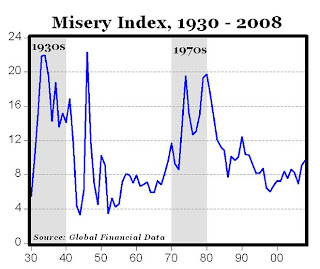I received an interesting question from a green industry grower this morning:
I appreciate your informative blog. Thanks. In the January conference we heard that on the rebound inflation will devalue dollars and we should convert cash to inventory as goods will increase in value. We also were advised to convert to fixed rates on loans. Our banker is unsure if we will see this inflation as we have in exiting past recessions. It seems that spending will continue to be weak for several years and commodities which were falsely valued high by traders are still in oversupply and profitable with foreign oil still draining too many dollars from the US at a healthy profit to producers and suppliers. Do you have any thoughts on this now you could post?
I think the best way to attack this question is by examining the usual components of inflation — that is, trends in the producer price index and the consumer price index.
In their report released on Aug 18, the BLS reported that wholesale prices in the U.S. fell more than forecast in July as energy costs receded, capping the biggest 12-month drop on record and showing inflation will not be an immediate concern for Federal Reserve policy makers.
The 0.9 percent decrease in prices paid to factories, farmers and other producers followed a 1.8 percent gain in June. Excluding food and fuel, so-called core prices unexpectedly fell 0.1 percent.
A record amount of excess capacity will prevent production bottlenecks from developing, indicating wholesale prices will be slow to recover even as the economy improves. A lack of inflation was one reason Fed policy makers last week reiterated a pledge to keep the benchmark interest low for an “extended period.”
On the consumer side of things,
U.S. consumer prices fell last month at their fastest annual pace since 1950, an indication that inflation isn’t a threat to the economy or the Federal Reserve. The consumer price index was unchanged on a monthly basis in July from June, the Labor Department said Friday, matching economist expectations, according to a Dow Jones Newswires survey.
The core CPI, which excludes food and energy prices, rose 0.1%, which was also in line with expectations. Unrounded, the CPI posted no change last month. The core CPI advanced 0.091% unrounded.
Consumer prices plunged 2.1% compared to one year ago, the largest 12-month decline since January 1950. Most Fed officials think a positive inflation rate around 2% is consistent with their dual mandate of price stability and maximum employment.
Even regarding inflationary pressures from an increase in the money supply, most economists now (in 2009) feel less inflationary pressures are likely. For example, Mark Perry reports:
There are some economists who are concerned about future inflation because of the loose, expansionary monetary policy in 2008. I don’t think inflation will be a problem, and here’s why:
The chart above shows the annual growth rate in the M2 money supply (percent change from the same month in the previous year, data here) monthly from January 1960 to July 2009. Notice that:
1. There was sustained double-digit money growth in two periods in the 1970s, and that is what generated the high double-digit inflation in that decade. There was double-digit M2 growth for 29 consecutive months from March 1971 to July 1973 (and nine straight months above 13%), and then again for 30 consecutive months from July 1975 to December 1977, with a high of almost 14% growth in early 1972 (see chart above).
2. There was double-digit M2 growth in 1983, but only for 12 months from January to December of 1983, and this monetary expansion wasn’t enough to cause inflation (see chart below). Inflation never rose above 5% for many years after the double-digit money growth of 1983.
3. There was double-digit money growth in September, November and December of 2001, but inflation in subsequent years never got above 5% (see chart below).
4. The peak monetary expansion of M2 in 2008 was below the peaks in 1971-1972, 1976-1977, 1983 and 2001 (see chart above), and during the recent monetary expansion there has been only one month of double-digit money growth, and that was the peak of 10% in January 2009.
Bottom Line: Without sustained double-digit M2 growth, we won’t have anything close to double-digit inflation. And the historical evidence during the two most recent experiences of double-digit money growth in 1983 and 2001 demonstrates that short periods of double-digit money growth aren’t enough to bring about inflationary pressures. And since recent M2 growth during the “loose” monetary policy of 2008 is actually lower than in 1983 and 2001, there probably can’t be any inflationary pressures that will lead to problems with future inflation. In other words, a single month of double-digit M2 growth in January 2009 isn’t expansionary enough to create inflation. Hope this helps, Mr. Grower.
Hope this helps, Mr. Grower.

